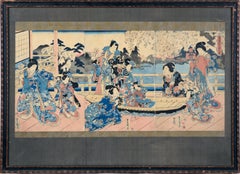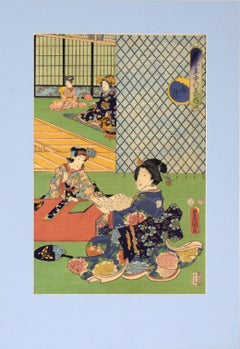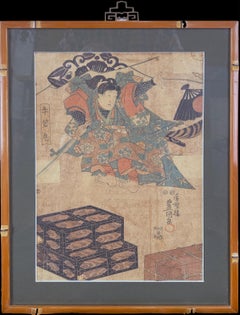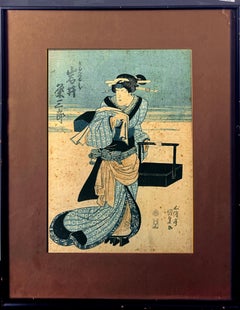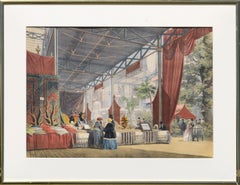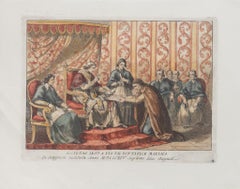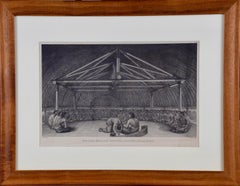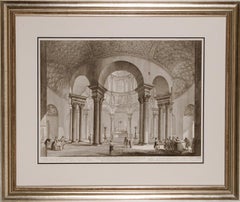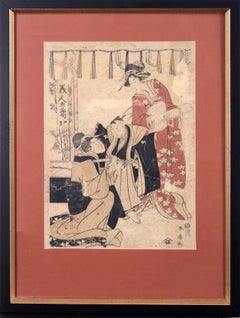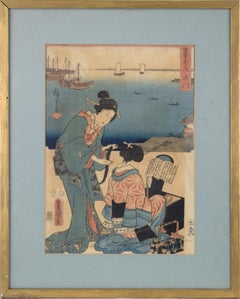1850s Interior Prints
to
2
1
3
1
1
Overall Width
to
Overall Height
to
1
4
1
126
223
1,120
774
11
13
21
54
37
85
83
215
252
83
104
3
3
6
3
3
3
2
2
1
1
1
4
4
4
3
3
4
1
5
1
Period: 1850s
Elegant Amusements of Eastern Genji - Japanese Triptych Woodblock Print on Paper
Located in Soquel, CA
Elegant Amusements of Eastern Genji - Japanese Triptych Woodblock Print on Paper
Dynamic woodblock print with several elegantly dressed figures by Utag...
Category
Edo 1850s Interior Prints
Materials
Paper, Ink, Woodcut
Annual Events for Young Murasaki (July) - Tales of Genji - Japanese Woodblock
Located in Soquel, CA
Annual Events for Young Murasaki (July) - Tales of Genji - Japanese Woodblock
Rightmost panel a triptych, depicting monthly events for Wakamurasaki (Young Murasaki). This is the month of July. There appears to be a lesson taking place, possibly for writing or poetry.
Artist: Toyokuni III/Kunisada (1786 - 1864)
Publisher: Ebisu-ya Shoshichist
Presented in a new blue mat.
Mat size: 19"H x 13"W
Paper size: 14.5"H x 10"W
Commentary on the triptych:
In the Edo period, Tanabata was designated as one of the five seasonal festivals, and became an annual event for the imperial court, aristocrats, and samurai families, and gradually came to be celebrated by the general public. Its origins are said to be a combination of the Kikoden festival, which originated from the Chinese legend of Altair and the Weaver Girl, and Japan's ancient Tanabata women's faith. Ink is ground with dew that has accumulated on potato leaves, poems and wishes are written on five colored strips of paper, which are then hung on bamboo branches to celebrate the two stars that meet once a year. Although the illustration is a Genji painting...
Category
Realist 1850s Interior Prints
Materials
Printer's Ink, Rice Paper, Woodcut
Kumasaka Chōhan to Ushiwakamaru - One of a Diptych Original Woodcut Print
Located in Soquel, CA
Kumasaka Chōhan to Ushiwakamaru is a Japanese Ukiyo-e print created between 1848 and 1854 by artist Utagawa Kunisada (Japanese, 1786-1864). The print is a Diptych, and is part of the...
Category
Realist 1850s Interior Prints
Materials
Printer's Ink, Rice Paper, Woodcut
Ichimura Uzaemon XIII - actor as Okaji of Gion, 1862 "The Six Poetry Immortals"
Located in Soquel, CA
Ichimura Uzaemon XIII - actor as Okaji of Gion, 1862 "The Six Poetry Immortals"
A Japanese Ukiyo-e woodcut print created circa 1862 by artist Utagawa Kunisada (Japanese, 1786-1864). ...
Category
Realist 1850s Interior Prints
Materials
Printer's Ink, Rice Paper, Woodcut
Mid 19th Century Figurative Scene from "Great Exhibition of 1851", London
By Lowes Cato Dickinson
Located in Soquel, CA
Hand-colored steel engraving of a the Turkish section of the Great Exhibition of 1851 by Lowes Cato Dickinson (British, 1819-1908). On verso i...
Category
Aesthetic Movement 1850s Interior Prints
Materials
Watercolor, Engraving
The Pope - Etching after Bartolomeo Pinelli - 1850
Located in Roma, IT
The Pope is an original Hand-colored etching artwork realized after Italian artist Bartolomeo Pinelli in 1850.
With the description of artwork on the lower i...
Category
Modern 1850s Interior Prints
Materials
Etching
Related Items
"King of the Friendly Islands" (Tonga); Engraving from Captain Cook's 3rd Voyage
By John Webber
Located in Alamo, CA
"Poulaho, King of the Friendly Islands, Drinking Kava" is an engraving created by William Sharp (1749-1824), from a drawing by John Webber (1752-1793), who was the artist on Captain James Cook's 3rd and final voyage of discovery. It was published in the atlas of "A Voyage to the Pacific Ocean Undertaken by the Command of His Majesty, for Making Discoveries in the Northern Hemisphere", the official British Admirality sanctioned journal published upon completion of the voyage in London in 1784 by Strahan & Cadell.
Captain Cook visited Tonga on his 3rd voyage, which he named The Friendly Islands because of the warm welcome he and his crew received, unlike some of the other more hostile Pacific islands. The engraving depicts Cook and his men observed a kava ceremony at the village of Mu’a on Tongatapu. King Paulaho sits in the centre foreground, his back to the spectator with a man kneeling before him. The ceremonial mat depicted behind Paulaho indicates that nobody was allowed to sit behind him. The figure in the centre holds a single cup, referring to the Tongan custom of offering the cup to the king first. Kava is native to the islands of the South Pacific and was first described for English readers in 1768 by Captain James Cook. The kava root has been used for centuries as a central feature of ceremonies and celebrations because it was able to bring about a calming and pleasant social atmosphere. The root was crushed and processed into coconut milk to become the focal ceremonial beverage, simply referred to as kava.
This engraving is presented in a Koa wood frame and a white mat. Koa wood is legendary in Hawaii. There are occasional faint spots, but the print is otherwise in very good condition. This amazing Koa wood is native to Hawaii and it is known for the deep rich colors and varied grain pattern. Koa has an honored heritage in Hawaii and is highly revered and sacred. The word “koa” means “warrior” in Hawaiian. The warriors of King Kamehameha the Great, created canoes and weapons from a wood plentiful on the Big Island of Hawaii. This wood became synonymous with the warriors themselves, and it became known as koa.
There are three other engravings listed from the official journal of Captain Cook's 3rd voyage available that are presented in identical Koa wood frames and mats (LU117324682422, LU117324684052, LU117324684032). They would make a wonderful grouping for a display of 2, 3 or 4 prints. A discount is available for a grouping depending on the number of items included.
Captain Cook is remembered as one of the greatest explorers and navigators in history. His explorations included Australia, New Zealand and islands of the South Pacific and the northwest coast of North America. Hawaii was discovered by Captain Cook during this voyage. Hawaii was originally called The Sandwich Islands in honor of The Earl of Sandwich...
Category
Realist 1850s Interior Prints
Materials
Engraving
$2,375
H 18.25 in W 23.5 in D 0.88 in
Church of St. Costanza, Rome: An 18th Century Piranesi Architectural Etching
Located in Alamo, CA
This is a framed 18th century Giovanni Battista Piranesi etching entitled: "Veduta interna del Sepocro di Santa Costanza, fabbricat...
Category
Old Masters 1850s Interior Prints
Materials
Etching
$3,775
H 27 in W 32 in D 1.5 in
A Framed 18th C. Piranesi Etching of an Ancient Marble Vase from Hadrian's Villa
Located in Alamo, CA
This large framed 18th century etching by Giovanni Battista Piranesi is entitled "Vaso antico di Marmo adornato di eccellenti Sculture si nella parte anteriere che nell' opposta, le ...
Category
Old Masters 1850s Interior Prints
Materials
Etching
$3,975
H 42.25 in W 26.5 in D 1.5 in
Inside the castle by David Hockney (Six Fairy Tales from the Brothers Grimm)
Located in New York, NY
From David Hockney’s celebrated Six Fairy Tales from the Brothers Grimm portfolio, an image of the story ‘The boy who left home to learn fear’. Hockney chose this story for its obscu...
Category
Modern 1850s Interior Prints
Materials
Etching, Aquatint
$2,250
H 17.75 in W 16 in
William P. Hicks, Circus
Located in New York, NY
William P. Hicks has drawn everything about the circus that will fit in the plate. The main figure is an aerial act with a woman balancing on rope held by a figure on the floor. Ther...
Category
American Modern 1850s Interior Prints
Materials
Etching
Home David Hockney (Six Fairy Tales from the Brothers Grimm) Clandeboye House
Located in New York, NY
From David Hockney’s celebrated Six Fairy Tales from the Brothers Grimm portfolio, an image from the story of ‘The boy who left home to learn fear’. Hockney chose this story for its ...
Category
Modern 1850s Interior Prints
Materials
Etching, Aquatint
$9,000
H 24.75 in W 17.75 in
The Roman Colosseum: A Framed 18th Century Etching of the Interior by Piranesi
Located in Alamo, CA
This large framed 18th century etching by Giovanni Battista Piranesi entitled "Veduta dell'interno dell'Anfiteatro Flavio detto il Colosseo" (View of the interior of the Flavian Amph...
Category
Old Masters 1850s Interior Prints
Materials
Etching
$5,875
H 28.88 in W 37.25 in D 1.25 in
The Lonely House at Asajigahara.
Located in Middletown, NY
A scene from a series of ghost stories and spooky rural legends.
Tokyo: Matsuki Heikichi, 1896.
Woodcut in ink with embossing and hand-coloring in watercolor on handmade mulberry pa...
Category
Edo 1850s Interior Prints
Materials
Watercolor, Handmade Paper, Woodcut
Knackers
Located in New Orleans, LA
Binyon 232 - A fine impression in fine condition in an edition of 55 signed and inscribed by the artist.
Strang was a prolific printmaker and across his lifetime produced over 750 o...
Category
Modern 1850s Interior Prints
Materials
Etching
Sculptured Marble in Classic Blue, Extra Large Cyanotype Print, Abstract Silk
By Kind of Cyan
Located in Barcelona, ES
This is an exclusive handprinted limited edition cyanotype.
Details:
+ Title: Marble Blue Silk Pattern
+ Year: 2022
+ Edition Size: 50
+ Medium: Cyanotype on Watercolor Paper
+ Sta...
Category
Abstract 1850s Interior Prints
Materials
Watercolor, Lithograph, Rag Paper, Emulsion
'The Bath' — Meji Era Cross-Cultural Woman Artist
By Helen Hyde
Located in Myrtle Beach, SC
Helen Hyde, 'The Bath', color woodblock print, edition not stated, 1905, Mason & Mason 59. Signed in pencil in the image, lower right. Numbered '96' in pencil in the image, lower left. The artist's monogram in the block, lower left, and 'Copyright, 1905, by Helen Hyde.' upper right. A superb impression with fresh colors on tissue-thin cream Japanese paper; the full sheet with margins (7/16 to 1 5/8 inches), in excellent condition. Matted to museum standards, unframed.
Image size 16 1⁄4 x 10 1⁄8 in. (413 x 260 mm); sheet size: 19 1⁄4 x 11 1⁄8 in. (489 x 283 mm).
Impressions of this work are held in the following collections: Achenbach Foundation for Graphic Arts, Art Institute of Chicago, Fine Arts Museums of San Francisco (De Young), Harvard Art Museums, Library of Congress, Metropolitan Museum of Art, New York Public Library, Smithsonian American Art Museum, Terra Foundation for American Art, University of Oregon Museum of Art.
ABOUT THE ARTIST
Helen Hyde (1868-1919) was a pioneer American artist best known for advancing Japanese woodblock printmaking in the United States and for bridging Western and Japanese artistic traditions. Hyde was born in Lima, New York, but after her father died in 1872, her family relocated to Oakland, California, where she spent much of her youth.
Hyde pursued formal art education in the United States and Europe. She enrolled in the San Francisco School of Design, where she took classes from the Impressionist painter Emil Carlsen; two years later, she transferred to the Art Students League in New York, studying there with Kenyon Cox. Eager to expand her artistic repertoire, Hyde traveled to Europe, studying under Franz Skarbina in Berlin and Raphael Collin in Paris. While in Paris, she first encountered Japanese ukiyo-e prints, sparking a lifelong fascination with Japanese aesthetics. After ten years of study, Hyde returned to San Francisco, where she continued to paint and began to exhibit her work.
Hyde learned to etch from her friend Josephine Hyde in about 1885. Her first plates, which she etched herself but had professionally printed, represented children. On sketching expeditions, she sought out quaint subjects for her etchings and watercolors. In 1897, Hyde made her first color etchings—inked á la poupée (applying different ink colors to a single printing plate)—which became the basis for her early reputation. She also enjoyed success as a book illustrator, and her images sometimes depicted the children of Chinatown.
After her mother died in 1899, Hyde sailed to Japan, accompanied by her friend Josephine, where she would reside, with only brief interruptions, until 1914. For over three years, she studied classical Japanese ink painting with the ninth and last master of the great Kano school of painters, Kano Tomonobu. She also studied with Emil Orlik, an Austrian artist working in Tokyo. Orlik sought to renew the old ukiyo-e tradition in what became the shin hanga “new woodcut prints” art movement. She immersed herself in the study of traditional Japanese printmaking techniques, apprenticing with master printer Kanō Tomonobu. Hyde adopted Japanese tools, materials, and techniques, choosing to employ the traditional Japanese system of using craftsmen to cut the multiple blocks and execute the exacting color printing of the images she created. Her lyrical works often depicted scenes of family domesticity, particularly focusing on women and children, rendered in delicate lines and muted colors.
Through her distinctive fusion of East and West, Hyde’s contributions to Western printmaking were groundbreaking. At a time when few Western women ventured to Japan, she mastered its artistic traditions and emerged as a significant figure in the international art scene.
Suffering from poor health, she returned to the United States in 1914, moving to Chicago. Having found restored health and new inspiration during an extended trip to Mexico in 1911, Hyde continued to seek out warmer climates and new subject matter. During the winter of 1916, Hyde was a houseguest at Chicora Wood, the Georgetown, South Carolina, plantation illustrated by Alice Ravenel Huger Smith in Elizabeth Allston Pringle’s 1914 book A Woman Rice Planter. The Lowcountry was a revelation for Hyde. She temporarily put aside her woodcuts and began creating sketches and intaglio etchings of Southern genre scenes and African Americans at work. During her stay, Hyde encouraged Smith’s burgeoning interest in Japanese printmaking and later helped facilitate an exhibition of Smith’s prints at the Art Institute of Chicago.
During World War I, Hyde designed posters for the Red Cross and produced color prints extolling the virtues of home-front diligence.
In ill health, Hyde traveled to be near her sister in Pasadena a few weeks before her death on May 13, 1919. She was buried in the family plot near Oakland, California.
Throughout her career, Hyde enjoyed substantial support from galleries and collectors in the States and in London. She exhibited works at the St. Louis Exposition in 1897, the Pan-American Exhibition in Buffalo in 1901, the Tokyo Exhibition for Native Art (where she won first prize for an ink drawing) in 1901, the Alaska-Yukon-Pacific Exhibition in Seattle in 1909 (received a gold medal for a print), the Newark Museum in 1913, a solo show at the Chicago Art Institute in 1916, and a memorial exhibition in 1920, Detroit Institute of Arts, Color Woodcut Exhibition in 1919, New York Public Library, American Woodblock Prints...
Category
Showa 1850s Interior Prints
Materials
Woodcut
Jan Oytenbogaert
Located in San Francisco, CA
This artwork titled Jan Uytenbogaert" 1639 is an etching on paper After Rembrandt Van Rijn, 1606-1669, plate engraved By French renown engraver Charles Armand Durand, 1831-1905. Sign...
Category
Realist 1850s Interior Prints
Materials
Etching
Previously Available Items
Dressing the Boy Samurai - Kuniyoshi Japanese Woodblock Print Original Wood Cut
Located in Soquel, CA
Dressing the Boy Samurai - Kuniyoshi Japanese Woodblock Print Original Wood Cut
A young Samurai boy is finishing dressing with the help of a younger sister while his mother looks on ...
Category
French School 1850s Interior Prints
Materials
Ink, Woodcut, Laid Paper
Dressing Room 53 Stations of Tokaido - Woodblock Utagawa Hiroshige and Kunisada
Located in Soquel, CA
Dressing Room 53 Stations of Tokaido - Woodblock Utagawa Hiroshige and Kunisada
Elegant woodblock print by Utagawa Hiroshige I (Japanese, 1797–1858) and Utagawa Kunisada I...
Category
Edo 1850s Interior Prints
Materials
Paper, Ink, Woodcut
RAG GATHERERS
Located in Santa Monica, CA
JAMES Abbott McNeill WHISTLER (1834-1903)
THE RAG GATHERERS 1858 (K.23 v/v)
Etching on laid paper. Signed and dated "Whistler 1858" in plate. Image 6" x 3 ½ inches. Sheet 7 ¾ x 5 ...
Category
Impressionist 1850s Interior Prints
Materials
Etching
Pair of Colored Engravings of the Crystal Palace; London's 1851 Great Exposition
By Samuel Read
Located in Alamo, CA
A pair of colored steel engravings from "The World's Metropolis, or Mighty London, Illustrated by a Series of Views Beautifully Engraved on Steel", published in London from 1851-1855 to commemorate London's Great Exhibition of 1851, also known as the Crystal Palace...
Category
Realist 1850s Interior Prints
Materials
Engraving
H 12.5 in W 15.5 in D 1 in
Scene from "Great Exhibition of 1851" London
By Lowes Cato Dickinson
Located in Soquel, CA
Hand -colored steel engraving of a the Turkish section of the Great Exhibition of 1851 London by Lowes Cato Dickinson (British, 1819-1908). In...
Category
Aesthetic Movement 1850s Interior Prints
Materials
Watercolor, Engraving
H 18.13 in W 24.13 in D 0.75 in
